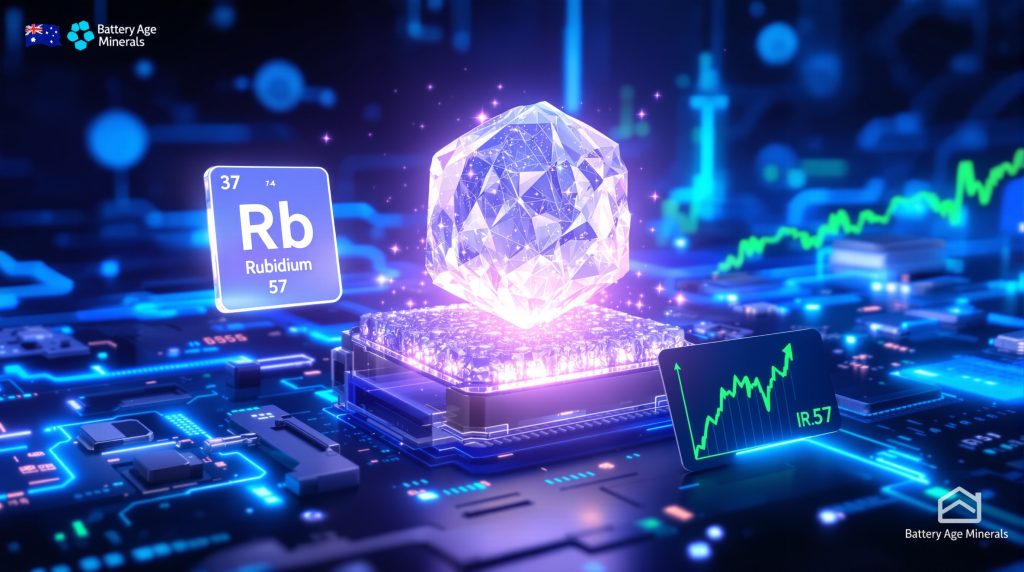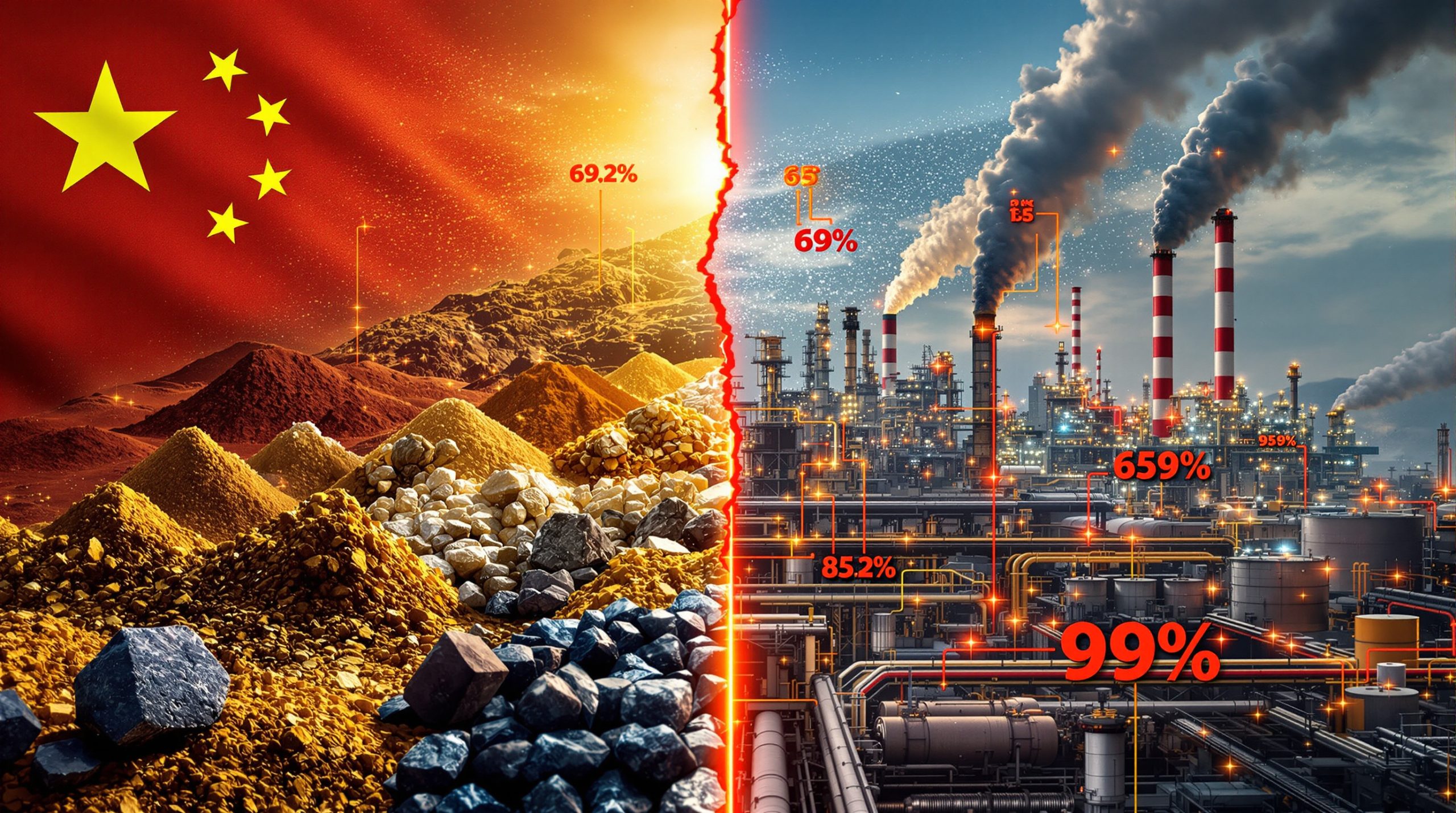Rubidium: The Forgotten Critical Mineral Making a Comeback in Battery Technology
Rubidium, a silvery-white alkali metal with atomic number 37, has remained largely in the shadows of resource discussions until recently. Despite being relatively abundant in the Earth’s crust (approximately 90 parts per million), this element has been overshadowed by more prominent critical minerals like lithium, cobalt, and rare earth elements. Now, this obscure element is experiencing a remarkable renaissance in technological applications.
After briefly capturing attention during the supply chain disruptions of the early 2020s, rubidium virtually disappeared from market conversations. The element was fairly common across the small end of the ASX materials sector during the COVID-era when supply chain issues brought shortages of nearly everything to the forefront. Now in 2025, rubidium is returning to the spotlight as battery manufacturers and technology companies recognize its unique potential.
The Overlooked Critical Mineral
Rubidium shares chemical properties with other alkali metals but offers distinctive characteristics that are becoming increasingly valuable in advanced technology applications. As part of Group 1 on the periodic table, it’s highly reactive, soft enough to cut with a knife, and has one of the lowest melting points among metals at just 39.3°C (102.7°F).
What makes rubidium particularly interesting is its position as a “bridge element” between the more common potassium and the more exotic cesium. This intermediate status has historically relegated it to niche applications, but recent technological developments are changing that perspective.
Resurgence in Critical Mineral Markets
The renewed interest in rubidium comes amid a broader trend of diversifying critical mineral sources and reducing dependency on geographically concentrated supplies. As nations worldwide pursue critical minerals in energy transition goals, the search for alternative materials has intensified, bringing previously overlooked elements into consideration.
Industry analysts point to rubidium’s unique properties as driving this resurgence. Unlike many critical minerals facing severe supply constraints, rubidium remains relatively accessible as a byproduct of existing mining operations, positioning it as a potential solution for manufacturers seeking to diversify their material inputs.
How Does Rubidium Enhance Battery Technology?
Rubidium’s emergence in battery technology represents one of the most promising developments for this element. While it won’t replace lithium as the primary component in rechargeable batteries, its role as a performance-enhancing additive is generating significant interest.
Technical Applications in Energy Storage
When incorporated into certain battery chemistries, rubidium can enhance ion conductivity and charge transfer kinetics. Research indicates that rubidium-doped cathode materials demonstrate improved thermal stability and longer cycle life compared to conventional formulations.
The element’s large ionic radius and low ionization energy create unique electrochemical properties that battery manufacturers are beginning to exploit. In solid-state battery research, rubidium compounds have shown promise as components in advanced electrolytes, potentially addressing persistent challenges in this next-generation technology.
For specific battery chemistries, particularly those using sulfide-based solid electrolytes, the addition of rubidium can stabilize crystal structures and enhance overall performance. These improvements translate to batteries with potentially faster charging capabilities and greater resilience to temperature fluctuations.
Beyond Batteries: Other High-Tech Uses
The applications for rubidium extend well beyond energy storage into numerous high-tech fields:
- Atomic clocks and quantum computing: Rubidium’s precise electron transition frequencies make it valuable for time-keeping applications and quantum information processing
- Fiber optic telecommunications: Specialized glass containing rubidium compounds improves signal transmission properties
- Medical imaging technologies: Rubidium-82 serves as a radioactive tracer in cardiac positron emission tomography (PET) scans
- Night vision devices: Photocells utilizing rubidium’s photoelectric properties enhance sensitivity to infrared light
- Space propulsion systems: Ionic propulsion technologies leverage rubidium’s low ionization energy
This diversity of applications provides multiple demand drivers for rubidium production, reducing market risk compared to elements dependent on a single industrial use.
Which Companies Are Leading the Rubidium Exploration Race?
The race to secure rubidium resources remains in its early stages, with few companies explicitly targeting this element. However, several junior miners with lithium, cesium, or potassium assets are discovering significant rubidium values within their existing projects.
Battery Age Minerals’ Strategic Position
Battery Age Minerals (ASX:BM8) has emerged as an early mover in the rubidium space, with recent exploration results highlighting significant concentrations at its Falcon Lake project. The company reported impressive rubidium assays reaching 11,400 parts per million (ppm), positioning it as a potential polymetallic resource with both lithium and rubidium value propositions.
“The multi-element database review confirms we are defining not just a potential high-grade lithium system, but a project enriched in several critical metals that are in high demand globally,” noted Nigel Broomham, CEO of Battery Age Minerals, in a recent announcement.
This dual-mineral approach provides a strategic hedge against market volatility in either commodity. The company’s junior mining exploration strategies demonstrate the potential for economic recovery of multiple elements from a single operation, potentially improving project economics.
Market Response to Polymetallic Discoveries
The market has responded positively to Battery Age’s announcement, with shares climbing approximately 19% during mid-day trading on August 14, 2025. This suggests investors are beginning to recognize the potential value of diversified critical mineral portfolios that include lesser-known elements like rubidium alongside more established battery metals like lithium.
While Battery Age Minerals remains in the exploration phase with a modest market capitalization of approximately $12.29 million, its early recognition of rubidium’s potential value demonstrates the kind of forward-thinking approach that could position junior miners for success in evolving critical mineral markets.
What Makes Rubidium Valuable in Today’s Market?
The growing value proposition for rubidium stems from a combination of limited production, specialized applications, and increasing technological demand. Unlike mass-market metals with established commodity trading frameworks, rubidium occupies a more specialized market position.
Supply Constraints and Strategic Importance
Unlike more common battery metals, rubidium production remains limited globally. The element is typically recovered as a byproduct from lithium, cesium, or potassium mining operations rather than from dedicated rubidium mines. This production method creates natural supply constraints that could become increasingly significant as demand grows for specialized applications.
While rubidium is actually more abundant in the Earth’s crust than lithium (90 ppm vs. 20 ppm), economically viable concentrations remain rare. The highest-grade deposits often occur in specialized granite pegmatites, particularly those containing lithium-cesium-tantalum (LCT) mineral assemblages.
The current global production of refined rubidium compounds remains limited to less than 100 tonnes annually, according to industry estimates. This restricted supply creates potential opportunities for early movers who can establish production capabilities ahead of growing demand.
Price Dynamics and Market Development
While rubidium doesn’t have the same established commodity markets as lithium or cobalt, its specialized applications command premium pricing. High-purity rubidium compounds can sell for thousands of dollars per kilogram, though market transparency remains limited.
The pricing structure for rubidium follows a tiered model based on purity and form:
- Industrial-grade rubidium compounds: $800-1,500 per kilogram
- Technical-grade rubidium metal: $3,000-5,000 per kilogram
- Research-grade high-purity rubidium: $5,000-7,000 per kilogram
As industrial applications expand, market mechanisms for rubidium trading and pricing are likely to develop further. Companies establishing early positions in this space may benefit from preferred supplier status as industrial demand grows.
How Does Rubidium Fit into the Broader Critical Minerals Landscape?
The emergence of rubidium as a mineral of interest reflects broader trends in critical mineral markets, where previously overlooked elements are gaining recognition for their technological importance. Understanding this context helps evaluate rubidium’s potential trajectory.
Comparison with Other Emerging Critical Minerals
Rubidium joins a growing list of previously overlooked elements gaining attention in critical mineral discussions. Similar to antimony (which has seen increased interest due to its applications in fire retardants and batteries) and scandium (valued for aerospace alloys), rubidium represents part of a “second wave” of critical minerals becoming strategically important for advanced technologies.
| Critical Mineral | Primary Battery Applications | Global Production (est. 2024) | Price Range (USD/kg) | Supply Risk Level |
|---|---|---|---|---|
| Lithium | Cathodes, electrolytes | 785,000 tonnes LCE | $15-25 | Moderate |
| Cobalt | Cathodes | 170,000 tonnes | $35-50 | High |
| Nickel (Class 1) | Cathodes | 2.8 million tonnes | $20-30 | Moderate |
| Graphite | Anodes | 1.1 million tonnes (battery) | $700-1,500 | Moderate |
| Manganese | Cathodes | 20 million tonnes | $2-5 | Low |
| Rubidium | Electrolytes, additives | <100 tonnes | $800-7,000 | High |
| Antimony | Anodes, fire retardants | 180,000 tonnes | $12-18 | High |
| Scandium | Solid-state components | <25 tonnes | $900-1,500 | Very High |
This comparison highlights rubidium’s position as a highly specialized element with significant price premium and supply constraints relative to more established battery materials.
Government Recognition and Classification
Several countries have updated their critical minerals lists to include rubidium, acknowledging its importance to technological development and potential supply vulnerabilities. This official recognition often precedes increased investment in exploration and recovery technologies, potentially accelerating market development.
The inclusion of rubidium on critical minerals lists enables access to government incentives, research funding, and strategic investment programs designed to secure supply chains for technologies considered vital to national interests. For junior miners with rubidium potential, these programs could provide valuable support for project development.
What Do Battery Age Minerals’ Recent Results Tell Us?
Battery Age Minerals’ recent exploration results provide insight into both the technical potential of rubidium resources and market receptivity to this emerging opportunity. Analyzing these findings helps understand the practical implications of rubidium’s resurgence.
Dual-Commodity Potential at Falcon Lake
Battery Age Minerals’ recent exploration results demonstrate the polymetallic nature of its Falcon Lake asset. Beyond the headline-grabbing rubidium values (up to 11,400ppm), the company reported substantial lithium intercepts, including:
- Two intercepts exceeding 50 meters in length
- Grades of 1.75% and 1.5% lithium respectively
- Multiple wider-zone mineralized areas
These findings suggest potential for economic recovery of both elements from the same resource, potentially improving overall project economics. The co-occurrence of lithium and rubidium is geologically logical, as both elements often concentrate in similar pegmatite formations through comparable geochemical processes.
The grade of 11,400ppm (1.14%) rubidium represents a significantly enriched concentration compared to average crustal abundance. For context, economic lithium deposits typically contain 0.5-2% lithium, suggesting that similar concentration factors may apply for rubidium resources.
Strategic Timing Amid Market Recovery
The company’s announcement comes at a potentially advantageous moment, with early signs of recovery appearing in lithium markets. CEO Nigel Broomham emphasized that the company remains “strategically placed to recommence on-ground work at Falcon Lake as commodity markets continue to strengthen,” suggesting confidence in improving market conditions for battery metals investment.
With a share price of 8 cents and market capitalization of approximately $12.29 million, Battery Age Minerals represents an early-stage opportunity in the rubidium space. The positive market response to its announcement (+19% share price movement) indicates investor receptivity to the rubidium value proposition, particularly when paired with more established battery metals.
Is the Lithium Market Really Recovering?
The context of lithium market conditions provides important background for understanding rubidium’s potential trajectory, as many potential rubidium producers are primarily focused on lithium. Recent developments suggest potential shifts in lithium market dynamics.
Recent Market Catalysts
Recent developments have sparked renewed optimism in lithium markets. The closure of CATL’s Jianxiawo mine created a temporary surge in lithium stocks, though this operation represents only about 3% of global lithium supply. Nevertheless, the market reaction demonstrates the sensitivity of lithium equities to supply disruption news.
As The Market Online noted, “the momentum from CATL’s Monday move won’t last. Now it’s up to swing traders to keep things going.” This perspective highlights the distinction between short-term trading catalysts and fundamental market shifts. While news-driven rallies may be temporary, they can create windows of opportunity for companies to secure financing or advance development plans.
For companies like Battery Age Minerals with dual exposure to lithium and rubidium, even temporary lithium market improvements can provide strategic advantages, potentially funding exploration work that enhances understanding of both commodities.
Longer-Term Market Fundamentals
While short-term price movements may be driven by news events and trader activity, longer-term lithium market fundamentals remain tied to electric vehicle adoption rates and energy storage deployment. Many analysts project supply-demand balances to tighten in the latter half of the decade as EV production continues scaling globally.
The lithium industry experienced significant overcapacity in 2023-2024, leading to price corrections and project delays. However, the underlying demand growth trajectory remains intact, with global EV sales projected to continue expanding at double-digit rates through the end of the decade.
This longer-term view suggests potential for recovery in lithium markets, which could create favorable conditions for advancing polymetallic projects containing both lithium and rubidium. Companies positioned with exposure to both elements may benefit from multiple market recovery scenarios.
What Should Investors Know About Battery Age Minerals?
For investors considering exposure to the rubidium theme, Battery Age Minerals represents one of the few publicly traded companies explicitly highlighting rubidium potential. Understanding the company’s position and associated risk factors provides context for investment consideration.
Company Fundamentals and Market Position
With a market capitalization of approximately $12.29 million as of August 2025, Battery Age Minerals represents an early-stage exploration company focused on battery metals. The company’s share price of 8 cents reflects both the speculative nature of junior mining investments and the potential upside if exploration success continues.
The company’s Falcon Lake project has demonstrated significant potential for both lithium and rubidium, with recent results highlighting:
- Rubidium values up to 11,400ppm (1.14%)
- Lithium intercepts over 50 meters with grades up to 1.75%
- Multiple mineralized zones requiring further exploration
This dual-commodity exposure provides potential diversification benefits while maintaining focus within the battery materials sector. The company appears well-positioned to advance exploration as market conditions improve.
Risk Factors and Considerations
Investors considering exposure to rubidium through companies like Battery Age should recognize several key risk factors:
- Early exploration stage: The company has not yet defined mineral reserves according to industry standards
- Commodity price volatility: Both lithium and rubidium markets experience significant price fluctuations
- Processing challenges: Extracting and purifying multiple elements may present technical hurdles
- Market size limitations: The rubidium market remains small compared to mainstream battery metals
- Capital requirements: Advancing from exploration to production will require substantial additional funding
- Regulatory uncertainties: Permitting and environmental approvals introduce timeline risks
These factors highlight the speculative nature of early-stage critical mineral investments. Investors should consider such opportunities as representing higher-risk allocations within a diversified portfolio, with corresponding potential for outsized returns if successful.
How Might the Critical Minerals Landscape Evolve?
The emergence of rubidium as a mineral of interest reflects broader evolutionary trends in critical minerals markets. Understanding these potential trajectories helps contextualize current developments within longer-term industry shifts.
Diversification of Battery Chemistries
As battery technology continues advancing, manufacturers are exploring increasingly diverse material inputs to optimize performance, reduce costs, and mitigate supply risks. This trend supports increased interest in previously overlooked elements like rubidium that may offer performance advantages in specific applications.
The battery industry is moving beyond the dominant lithium-ion paradigm to explore multiple chemistry variants optimized for different applications:
- Sodium-ion batteries for stationary storage
- Solid-state batteries for higher energy density
- Flow batteries for grid-scale applications
- Silicon-enhanced anodes for improved capacity
Each chemistry variant introduces different material requirements, potentially creating new markets for elements not currently used in mainstream batteries. Rubidium’s potential role in solid-state electrolytes represents one such opportunity, though commercial deployment timelines remain uncertain.
Government Support and Strategic Investments
National security considerations are driving increased government support for critical mineral development globally. Australia, the United States, and other countries have implemented or expanded programs to accelerate exploration, processing capabilities, and supply chain development for battery and technology metals.
These initiatives often include:
- Direct funding for exploration and processing development
- Tax incentives for critical mineral projects
- Streamlined permitting for strategic resources
- Research funding for improved recovery technologies
- Investment in refining and manufacturing capabilities
For junior miners exploring for elements like rubidium, these programs can provide essential financial and regulatory support. As governments expand their critical minerals lists to include more specialized elements, companies with exposure to these materials may benefit from increased policy attention and investment.
FAQ: Understanding Rubidium and Battery Minerals
What is rubidium used for in batteries?
Rubidium can function as a dopant in certain battery cathode materials, potentially improving ion conductivity and electrochemical performance. It may also play roles in solid-state electrolyte development and specialized battery applications requiring high energy density.
The element’s large ionic radius and low ionization energy create unique properties when incorporated into battery materials. Research indicates potential benefits including improved ion mobility, enhanced thermal stability, and better cycle life in certain battery chemistries, particularly those using sulfide-based solid electrolytes.
How rare is rubidium compared to lithium?
Rubidium is actually more abundant in the Earth’s crust than lithium, with an average concentration of about 90 parts per million compared to lithium’s 20 parts per million. However, economically viable concentrations of rubidium are much rarer, and the element is typically recovered as a byproduct rather than from dedicated mines.
The disconnect between natural abundance and economic availability stems from rubidium’s geochemical behavior. While widely distributed throughout crustal rocks, it rarely forms its own minerals, instead substituting into the crystal structures of more common elements like potassium. This distribution pattern makes concentrated deposits relatively uncommon.
What other companies are exploring for rubidium?
While Battery Age Minerals has recently highlighted rubidium in its exploration results, several other companies have rubidium potential in their mineral portfolios, though often as secondary targets to lithium, cesium, or potassium. The market remains relatively underdeveloped compared to more established battery metals.
Companies with exposure to LCT (lithium-cesium-tantalum) pegmatites often have the geological potential for rubidium, even if not explicitly targeting this element. As market awareness grows, more companies may begin assaying for and reporting rubidium values from existing projects.
Could rubidium replace lithium in batteries?
Rubidium is unlikely to replace lithium as the primary component in rechargeable batteries due to cost, weight, and electrochemical differences. However, it may find increasing use as an additive or enhancer in certain battery chemistries, complementing rather than replacing lithium.
From a technical perspective, rubidium’s higher atomic weight (approximately 85 g/mol compared to lithium’s 7 g/mol) makes it less suitable for applications where energy density per weight is critical, such as electric vehicles. However, its unique properties may prove advantageous in stationary storage applications where weight constraints are less significant.
What price does rubidium command in the market?
Rubidium pricing varies significantly based on purity and form. Industrial-grade rubidium compounds might sell for hundreds of dollars per kilogram, while high-purity research-grade materials can cost thousands of dollars per kilogram. The market lacks the transparency and established benchmarks of more widely traded metals.
This price range reflects rubidium’s position as a specialty chemical rather than a bulk commodity. As industrial applications expand, pricing mechanisms may become more standardized, but the element is likely to maintain premium pricing relative to mass-market metals due to its specialized applications and limited production.
Further Exploration:
Readers interested in learning more about emerging battery minerals and critical resource developments can explore related market news and analysis at various industry publications and market research firms specializing in critical minerals and battery recycling breakthrough and lithium refinery innovations.
Want to Know When the Next Big ASX Mining Discovery Happens?
Don’t miss potential investment opportunities in emerging minerals like rubidium. Discovery Alert’s proprietary Discovery IQ model provides instant notifications when significant mineral discoveries are announced on the ASX, giving you a crucial market advantage. Explore how historic discoveries have generated substantial returns by visiting the Discovery Alert discoveries page.




